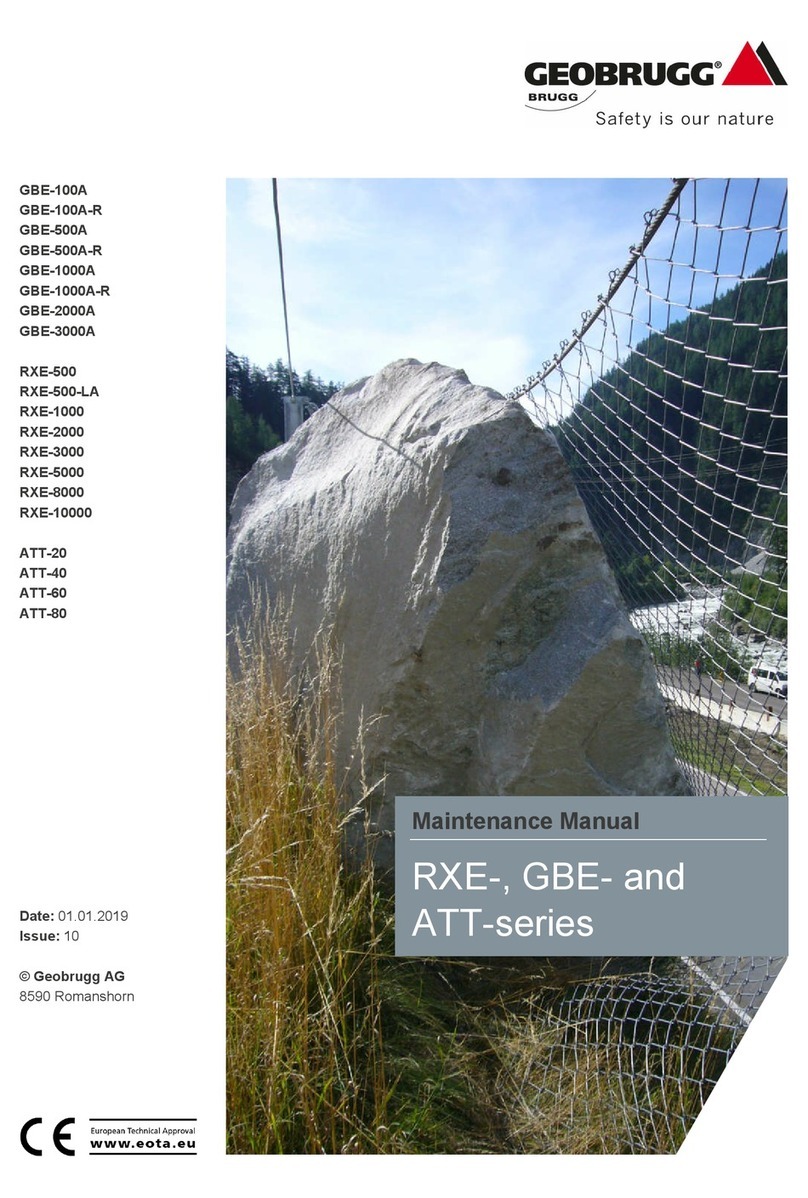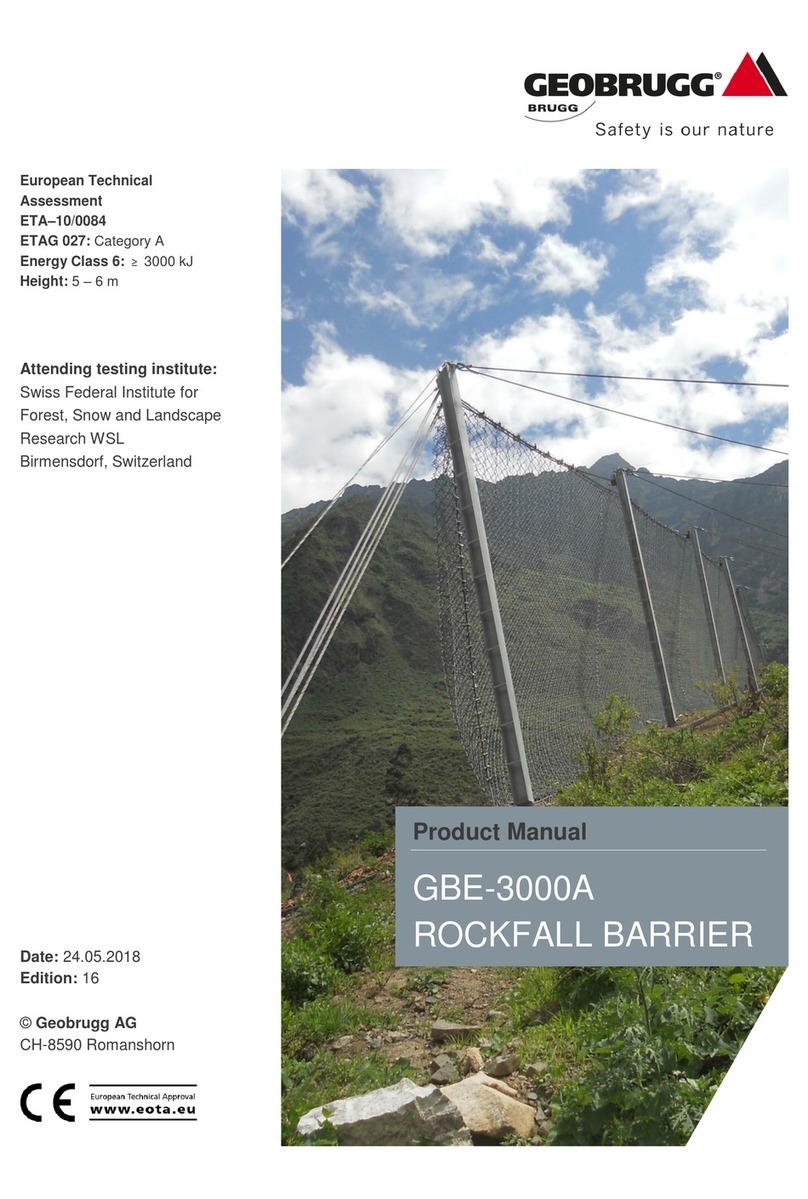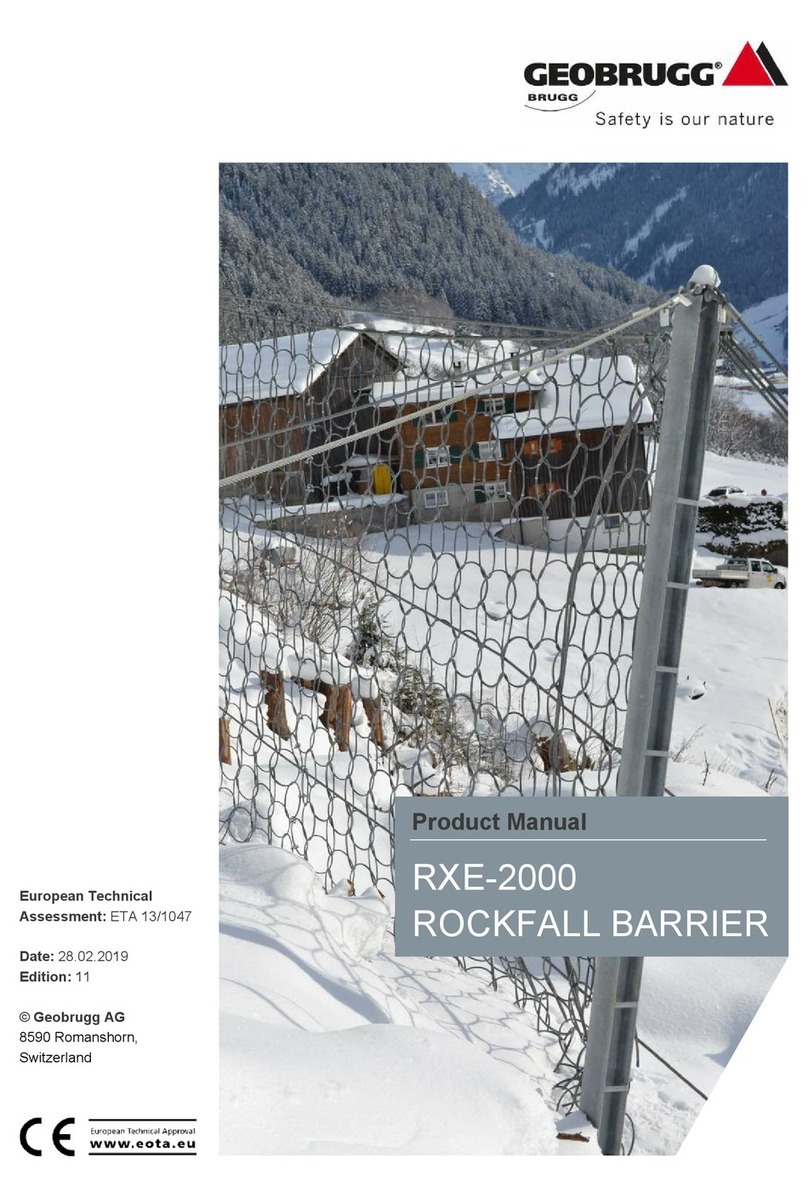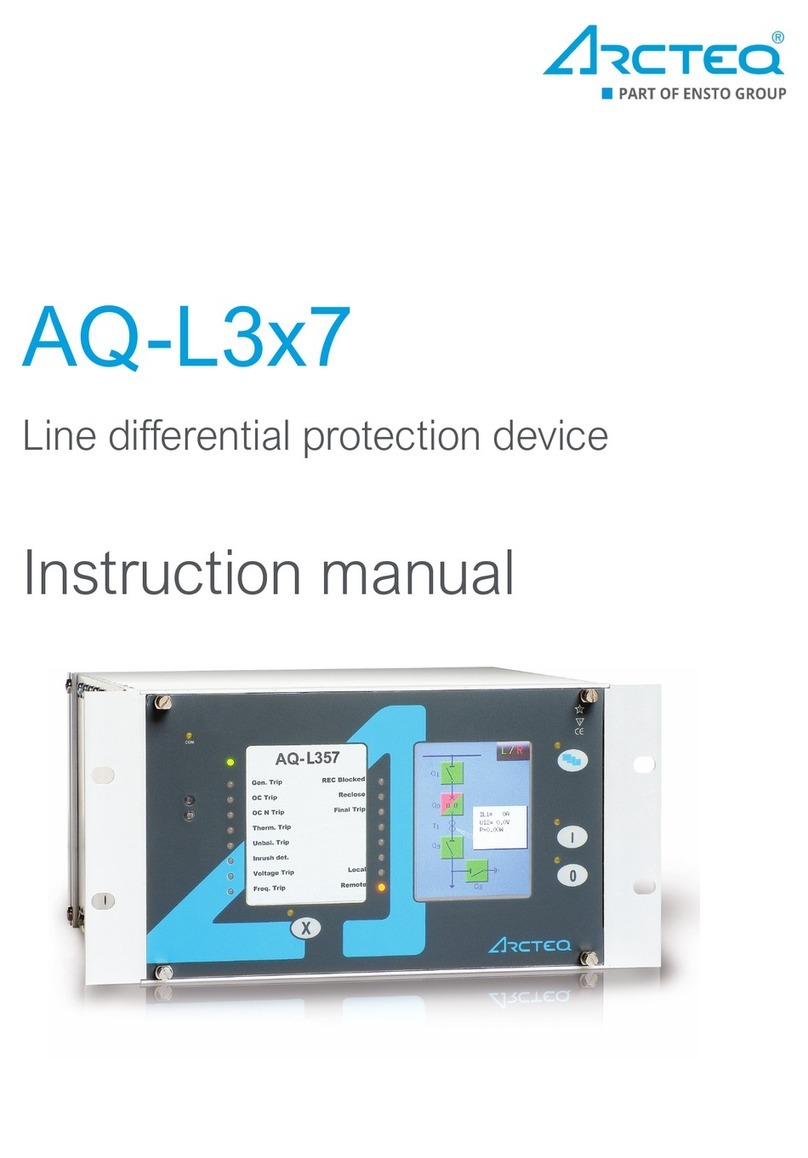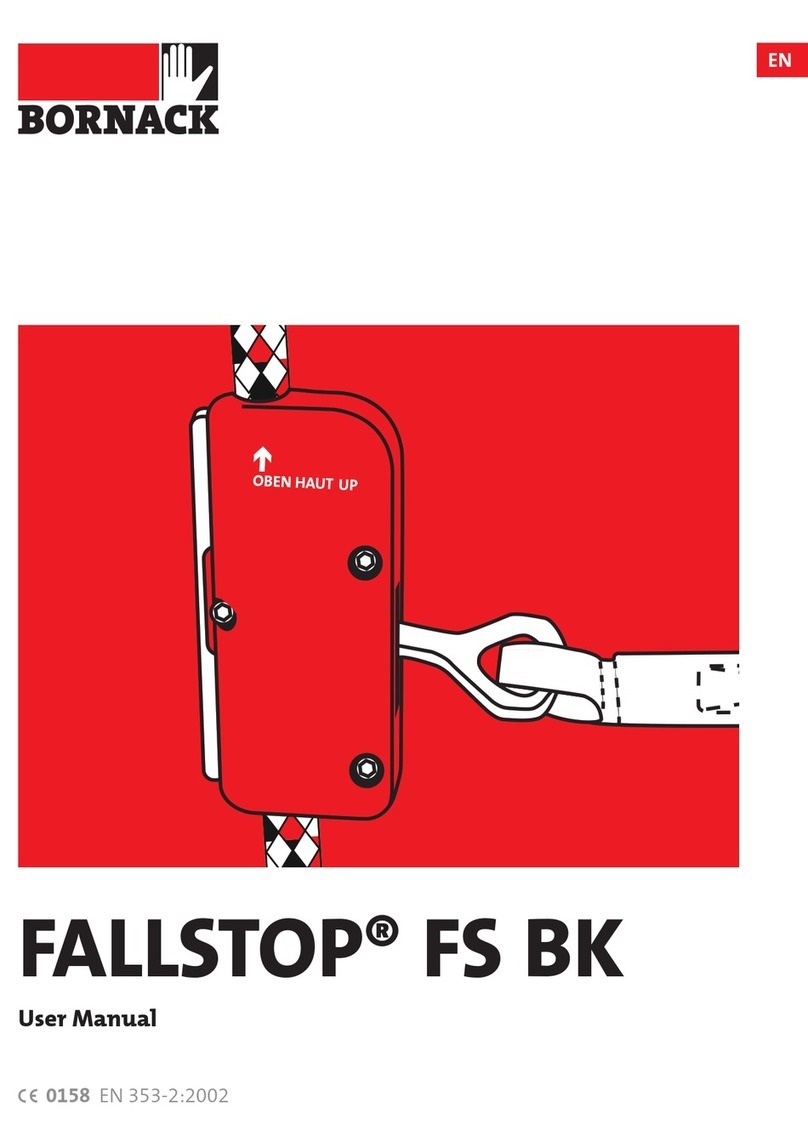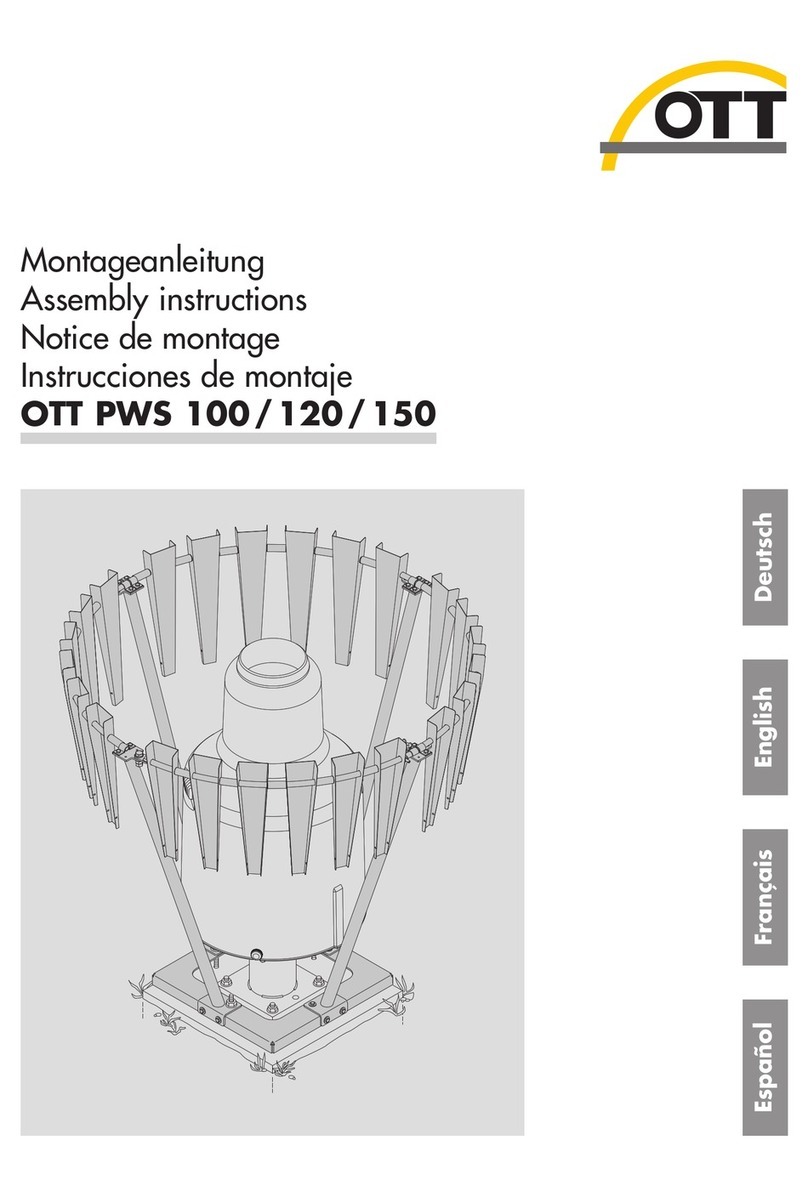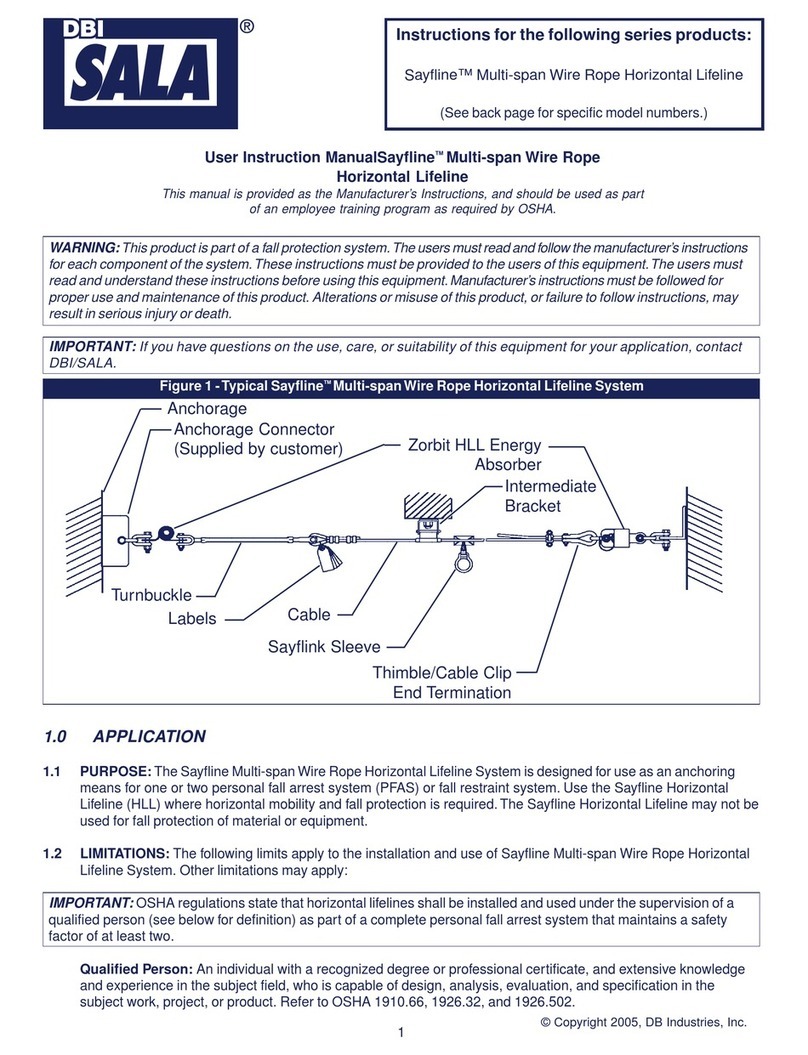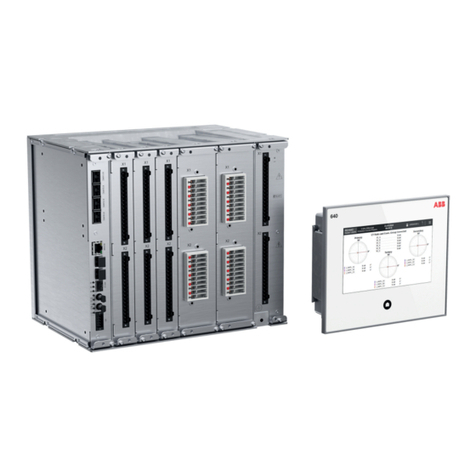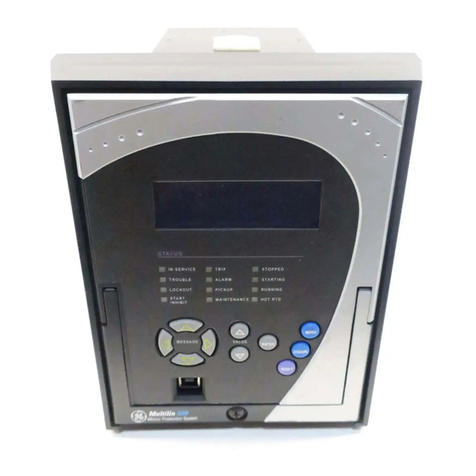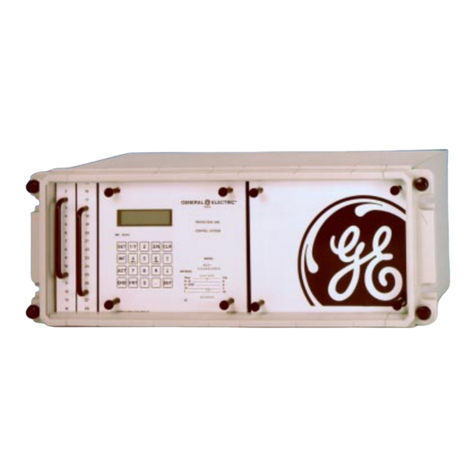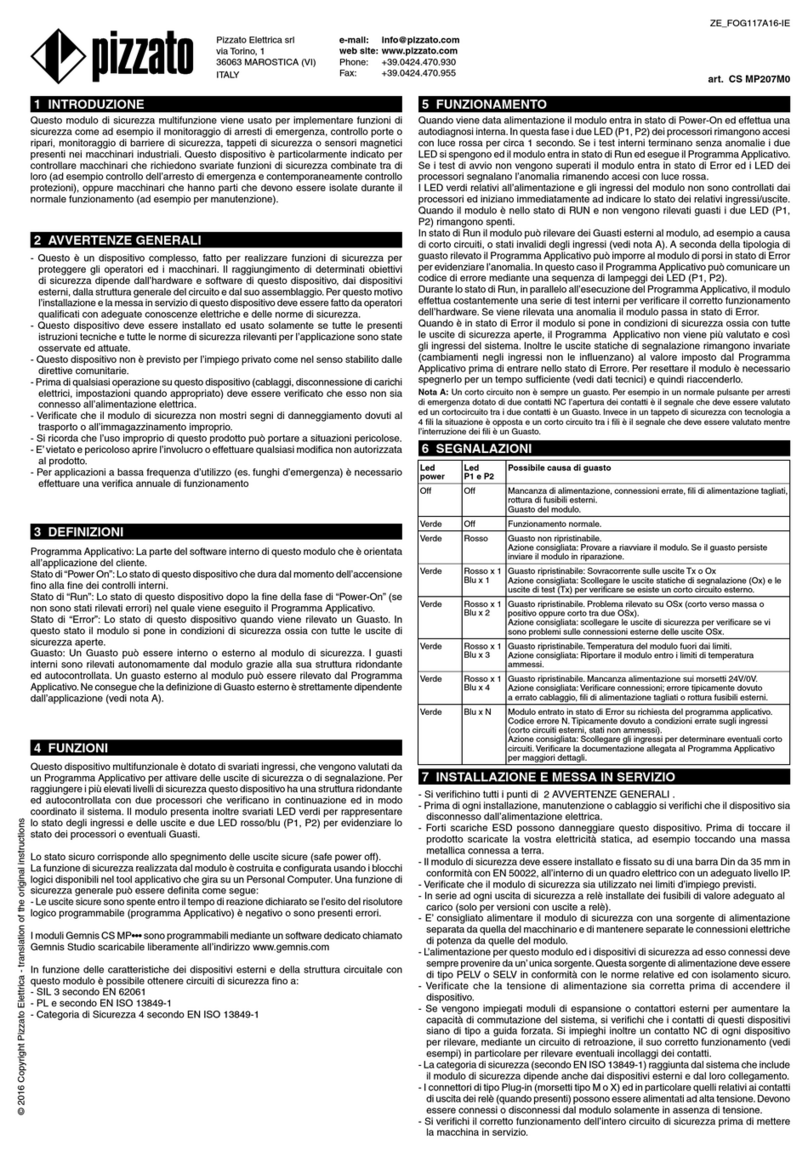Geobrugg ROCCO Series User manual

GBE-100A
GBE-100A-R
GBE-500A
GBE-500A-R
GBE-1000A
GBE-1000A-R
GBE-2000A
GBE-3000A
RXE-500
RXE-500-LA
RXE-1000
RXE-2000
RXE-3000
RXE-5000
RXE-8000
RXE-10000
ROCCO-1000
ROCCO-2000
ROCCO-3000
ATT-20
ATT-40
ATT-60
ATT-80
Date: 12.01.2023
Issue: 13
© Geobrugg AG
8590 Romanshorn
Maintenance Manual
GBE-, RXE-, ROCCO
and ATT-series

Page 2/33
© Geobrugg Gruppe, CH-8590 Romanshorn, Switzerland Maintenance manual GBE, RXE, ROCCO and ATT / 13
PURPOSE AND ORGANIZATION OF THE MAINTENANCE MANUAL
This maintenance manual is intended for the proper maintenance and repair of a rockfall protection system, in order
to ensure a long lifespan for the barrier, and its unrestricted and safe functioning following impacts and throughout
its lifespan. The maintenance manual is to be understood as a recommendation. Only standard situations are de-
scribed. In the event of unusual situations, this manual may under certain circumstances be inappropriate or inad-
equate for servicing or repairing the barrier. In certain cases, it is recommended that technical advice is obtained
from the manufacturer.
This maintenance manual consists of the following sections:
•Lifespan
•Inspections
•Criteria for repairs and replacement
•Emptying and clearing of barriers
•Repairing and replacing components
•Inspection checklist
•ISO 9001 certificates
No claims are made that this document is complete. It is designed for general standard applications and does not
take into account project-specific parameters. Geobrugg cannot be held liable for any extra costs that may be
incurred for special cases. In the event of uncertainty, please contact the manufacturer. The General Terms of
Business of Geobrugg AG apply.
RESPONSIBLE FOR THE CONTENT:
Geobrugg AG
Geohazard Solutions
Aachstrasse 11
CH-8590 Romanshorn, Switzerland
www.geobrugg.com
Romanshorn, 12.01.2023
(Stamp / legally valid signatures)

Page 3/33
© Geobrugg Gruppe, CH-8590 Romanshorn, Switzerland Maintenance manual GBE, RXE, ROCCO and ATT / 13
I AREA OF APPLICATION
This maintenance manual applies for the Geobrugg rockfall barrier systems of the GBE, RXE, ROCCO and ATT
series. Reference is made to the corresponding system drawings:
GBE-100A (100 kJ) System drawing GS-1218
GBE-100A-R (100 kJ) System drawing GS-1131
GBE-500A (500 kJ) System drawing GS-1100
GBE-500A-R (500 kJ) System drawing GS-1122
GBE-1000A (1000 kJ) System drawing GS-1104
GBE-1000A-R (1000 kJ) System drawing GS-1128
GBE-2000A (2000 kJ) System drawing GS-1109
GBE-3000A (3000 kJ) System drawing GS-1113
RXE-500 (500 kJ) System drawing GS-1196
RXE-500-LA (500 kJ) System drawing GS-1216
RXE-1000 (1000 kJ) System drawing GS-1142
RXE-2000 (2000 kJ) System drawing GS-1150
RXE-3000 (3000 kJ) System drawing GS-1157
RXE-5000 (5000 kJ) System drawing GS-1125
RXE-8000 (8000 kJ) System drawing GS-1138
RXE-10000 (10000 kJ) System drawing GS-1552
ROCCO-1000 (1000 kJ) System drawing GS-1225
ROCCO-2000 (2000 kJ) System drawing GS-1222
ROCCO-3000 (3000 kJ) System drawing GS-1228
ATT-20 System drawing GS-1556
ATT-40 System drawing GS-1567
ATT-60 System drawing GS-1568
ATT-80 System drawing GS-1569
II QUALITY OF THE SYSTEM COMPONENTS
Geobrugg AG, Romanshorn, has been certified according to the quality management system requirements (ISO
9001:2015) under registration number CH-S34372 since August 22, 1995. The certifying body is the Swiss Asso-
ciation for Quality and Management Systems (SQS), a member of IQNet. The quality manual describes in full how
the individual system parts (input material, commercial products and end products) are comprehensively checked
in order to exclude inadequate quality.

Page 4/33
© Geobrugg Gruppe, CH-8590 Romanshorn, Switzerland Maintenance manual GBE, RXE, ROCCO and ATT / 13
III FUNCTIONAL EFFICIENCY OF THE BARRIER SYSTEMS
The system functionality is based on rockfall tests that replicate real-life conditions, performed in Walenstadt (SG),
Switzerland, in accordance with the European Guideline EAD-340059-00-0106-2018 “Falling Rock Protection Kits”
and the Swiss Guidance for Practice "Basics for the Quality Assessment of Rockfall Protection Nets and their
Foundation". In the rockfall tests under real-life conditions, the rocks are thrown vertically into the central field of a
three-field barrier with a 10 m distance between the posts of each field. An impact speed of at least 25 m/s is
achieved. These investigations are inspected by notified testing centres and obtain European approval, known as
ETA (European Technical Assessment), as well as partly a Swiss inspection certificate from the Federal Office for
the Environment (FOEN).
IV QUALITY CONTROL FOR MAINTENANCE
An inspection of damage should be made using the checklist in the maintenance manual. The maintenance manual
describes in detail the individual steps for how the barriers must be maintained by local contractors. The recording
of damage is, however, always subject to subjective criteria. In the event that doubts should arise for this reason,
the manufacturer should be contacted in order to ensure the continued quality and functional efficiency of the barrier.
V PRODUCT LIABILITY
Rockfall, landslides, debris flows or avalanches are sporadic and unpredictable. The cause may be human (build-
ings etc.), for example, or forces beyond human control (weather, earthquakes, etc.). The multiplicity of factors that
may trigger such events means that guaranteeing the safety of persons and property is not an exact science.
However, the risks of injury and loss of property can be substantially reduced by appropriate calculations that apply
good engineering practices, and by using predictable parameters along with the corresponding implementation of
flawless protective measures in identified risk areas.
The monitoring and maintenance of such systems is an absolute requirement to ensure the desired safety level.
System safety can also be compromised through events, natural disasters, inadequate dimensioning or failure to
use standard components, systems and original parts, but also through corrosion (caused by environmental pollu-
tion or other man-made factors as well as other external influences).
In contrast to the 1:1 rockfall tests, which indeed test an extreme load case but still only demonstrate a standardized
situation, in the field the layout and design of a protection system can vary greatly because of the topography. The
influence of such alterations and adaptations cannot always be determined exactly. Critical points are, for example,
post spacing, changes in direction, placement angle of the rope anchors, and the direction and velocity of impact.
Geobrugg can assist with estimating the influence of larger deviations and special situations and can offer recom-
mendations for feasible solutions. Geobrugg cannot, however, guarantee the same behaviour as in the 1:1 rockfall
tests. In critical cases, it is advisable to reinforce particular components as compared with the standard barrier.

Page 5/33
© Geobrugg Gruppe, CH-8590 Romanshorn, Switzerland Maintenance manual GBE, RXE, ROCCO and ATT / 13
CONTENTS
1HAZARD NOTES ................................................................................................................ 7
2LIFESPAN .......................................................................................................................... 8
2.1 Lifespan of the components in general.......................................................................................................8
2.1.1 Individual parts.................................................................................................................................................8
2.1.2 Assemblies.......................................................................................................................................................8
2.1.3 Safety factors...................................................................................................................................................8
3INSPECTIONS ................................................................................................................... 9
3.1 Regular inspections.......................................................................................................................................9
3.1.1 Interval for regular inspections.........................................................................................................................9
3.1.2 Minimum number of inspections......................................................................................................................9
3.2 Inspection following incidents .....................................................................................................................9
3.3 Accessibility...................................................................................................................................................9
4CRITERIA FOR REPAIR AND REPLACEMENT ................................................................. 10
4.1 Debris in the barrier.....................................................................................................................................10
4.2 Remaining usable height following an incident .......................................................................................10
4.3 U-brake..........................................................................................................................................................10
4.4 Meshes and nets..........................................................................................................................................10
4.4.1 TECCO...........................................................................................................................................................10
4.4.2 SPIDER..........................................................................................................................................................10
4.4.3 ROCCO..........................................................................................................................................................11
4.4.4 Wire mesh......................................................................................................................................................11
4.5 Ropes as per the rope assembling drawings ...........................................................................................11
4.5.1 Corrosion........................................................................................................................................................11
4.5.2 Mechanical damage.......................................................................................................................................11
4.6 Posts .............................................................................................................................................................11
4.7 Hinge bolt between post and base plate ...................................................................................................11
4.8 Base plate.....................................................................................................................................................11
4.9 Rod anchor of the base plate or post foot ................................................................................................11
4.10 Spiral rope anchor .......................................................................................................................................11
5CLEARING THE BARRIER ............................................................................................... 12
5.1 Breaking stones down.................................................................................................................................12
6TOOLS FOR SERVICING ROCKFALL BARRIERS ............................................................. 14
7USE OF WIRE ROPE CLIPS.............................................................................................. 15

Page 6/33
© Geobrugg Gruppe, CH-8590 Romanshorn, Switzerland Maintenance manual GBE, RXE, ROCCO and ATT / 13
7.1 Type EN 13411-5 type 1 (old type)..............................................................................................................15
7.2 Type FF-C-450 type 1 class 1 (new type)...................................................................................................16
8REPAIRING AND REPLACING COMPONENTS................................................................. 19
8.1 Geometrical arrangement of the components..........................................................................................19
8.2 Tightening sagging ropes...........................................................................................................................19
8.3 Replacing ropes...........................................................................................................................................20
8.4 Replacing U-brakes .....................................................................................................................................21
8.5 Repairing nets and meshes........................................................................................................................22
8.5.1 TECCO: repairing smaller mesh areas..........................................................................................................22
8.5.2 SPIDER: repairing smaller net areas.............................................................................................................22
8.5.3 ROCCO: repairing smaller net areas.............................................................................................................22
8.5.4 Secundary mesh: repairing smaller mesh areas ...........................................................................................22
8.6 Replacing nets and meshes........................................................................................................................23
8.6.1 TECCO: replacing a mesh field .....................................................................................................................23
8.6.2 SPIDER : replacing a net field .......................................................................................................................24
8.6.3 ROCCO: replacing individual rings................................................................................................................27
8.6.4 ROCCO: replacing a net field ........................................................................................................................28
8.6.5 Wire mesh: replacing a length of mesh .........................................................................................................29
8.7 Repairing ropes............................................................................................................................................29
8.8 Replacing ropes...........................................................................................................................................29
8.9 Replacing posts ...........................................................................................................................................29
8.9.1 Replacing middle posts..................................................................................................................................29
8.9.2 Replacing edge posts ....................................................................................................................................29
8.10 Replacing the hinge bolt between post and base plate...........................................................................30
8.11 Replacing a base plate ................................................................................................................................30
8.12 Replacing base plate anchors....................................................................................................................30
8.13 Replacing spiral rope anchors ...................................................................................................................30
9FINAL CHECK.................................................................................................................. 31

Page 7/33
© Geobrugg Gruppe, CH-8590 Romanshorn, Switzerland Maintenance manual GBE, RXE, ROCCO and ATT / 13
EXPLANATIONS OF THE SYMBOLS USED
Safety note: Must be followed
Note / reminder so that the system is easily and properly installed as well as maintained
Consultation with Geobrugg is recommended
Upslope
Downslope
1 HAZARD NOTES
QUALIFICATION OF THE GROUP LEADER
Only a qualified group leader may be put in charge of the maintenance.
TENSIONED ROPES
Ropes will be tensioned. When installing and pretensioning ropes, ensure that there are no persons
within in the danger area.
RELEASING TENSIONED PARTS
Releasing or separating tensioned parts should be avoided wherever possible. If this is necessary, how-
ever, please exercise the utmost caution.

Page 8/33
© Geobrugg Gruppe, CH-8590 Romanshorn, Switzerland Maintenance manual GBE, RXE, ROCCO and ATT / 13
2 LIFESPAN
2.1 Lifespan of the components in general
2.1.1 Individual parts
The lifespan of an individual part is defined by its load-bearing capacity. This includes e.g. the ropes, the rod an-
chors, the securing splints for the U-brake bolts etc.
2.1.2 Assemblies
The lifespan of an assembly is defined by itsload-bearing capacity as well as by its mechanical functional efficiency.
Typical assemblies include e.g. the installed barrier itself, the U-brakes and the running wheel groups.
2.1.3 Safety factors
If the functional efficiency or load-bearing capacity of the components is reduced as a result of damage or
corrosion, such that the minimum required safety factors can no longer be fulfilled, the components must
be replaced.

Page 9/33
© Geobrugg Gruppe, CH-8590 Romanshorn, Switzerland Maintenance manual GBE, RXE, ROCCO and ATT / 13
3 INSPECTIONS
In order to ensure that no damage or advanced corrosion impairs the functional efficiency or load-bearing
capacity of the components such that the minimum required safety factors can no longer be fulfilled, regu-
lar inspections of the barriers must be carried out.
3.1 Regular inspections
The first inspection is the factory acceptance. During the factory acceptance, the signature of the expert from the
manufacturer GEOBRUGG confirms the professional installation of the flexible safety structure and the legal
warranty for the work begins in full. We would like to point out that construction and/or assembly errors can lead to
functional errors which have a negative effect on the protective effect of the entire securing structure.
3.1.1 Interval for regular inspections
The appropriate interval depends primarily on the following parameters:
•Frequency of rockfall
•Corrosion class of the region / microclimate
•Vegetation
•Weather events
3.1.2 Minimum number of inspections
Under normal environmental conditions, one inspection per year is sufficient. If rockfall occur frequently, more in-
spections are appropriate. These should be carried out before the onset of winter or after the end of winter.
Digital monitoring devices on the flexible safety structures, such as the GUARD from Geobrugg AG, provide 24/7
access to the most important information about the current condition of the barrier, and any necessary maintenance
measures can be reliably defined. GUARD ensures that the condition of the flexible safety structures is monitored
between inspections.
Further information on our website www.geobrugg.com/guard
A useful aid for the systematic checking of the barrier is the “Barrier Inspection” checklist in the Annex.
3.2 Inspection following incidents
An inspection must be carried out immediately following any notified or recorded incidents.
A useful aid for the systematic checking of the barrier is the “Barrier Inspection” checklist in the Annex.
3.3 Accessibility
The barrier must be accessible so that all the components to be checked can be inspected without the
risk of accidents. The infrastructure required for this depends on the terrain.

Page 10/33
© Geobrugg Gruppe, CH-8590 Romanshorn, Switzerland Maintenance manual GBE, RXE, ROCCO and ATT / 13
4 CRITERIA FOR REPAIR AND REPLACEMENT
If the functional efficiency or load-bearing capacity of the components is reduced as a result of damage or
corrosion, such that the minimum required safety factors can no longer be fulfilled, the components must
be replaced. In order to be able to assess the condition and effectiveness of these flexible safety structures,
a basic knowledge of the individual components, their function and the interaction as an overall system is
required. This is what the CONSIS expert course offered by Geobrugg AG teaches. More information on
the requirements for participation and registration at https://www.geobrugg.com/en/Training-for-experts-
167821,104865.html
On the current expert database of our website you will find the certified experts with their main topics,
certainly also in your area: https://www.geobrugg.com/en/Expertdatabase-172717.html?formular_sub-
mit=1
4.1 Debris in the barrier
Any debris that accumulates in the barrier should not exceed a maximum of a third of the barrier height.
Routine clearing of the barriers is essential to ensure unimpeded functioning.
4.2 Remaining usable height following an incident
The remaining usable height of the barrier following an incident is an initial indicator of the level of damage that has
occurred. Clear sagging of the support rope or the net and a significant change in the angle of the posts indicate
an elongation of one or more U-brakes, which may need to be replaced.
4.3 U-brake
In the course of the EOTA certification tests, depending on their installation position the U-brakes became elongated
to varying degrees. Accordingly, following several minor incidents their energy absorption capacity for a subsequent
maximum incident varies.
Type
Maximum Elongation before replacement
U-150
30 cm
U-300
60 cm
U-400 / U-500
80 cm
If the initial elongation exceeds this value, the brake must be replaced. Once the U-brakes have become elongated,
the usable height of the barrier has decreased. By re-tightening the support ropes, the usable height can be restored
to its original value.
4.4 Meshes and nets
Even in the case of distorted wires or strands, as a rule it is not necessary to replace whole fields.
4.4.1 TECCO
If there are compressed, heavily distorted or torn mesh loops, these areas should be repaired.
4.4.2 SPIDER
If there are compressed, heavily distorted or superficially or completely torn mesh loops, these areas should be
repaired.

Page 11/33
© Geobrugg Gruppe, CH-8590 Romanshorn, Switzerland Maintenance manual GBE, RXE, ROCCO and ATT / 13
4.4.3 ROCCO
If individual wires have slipped out of a clip, they should be secured with a wire rope clip of a suitable
size.
If there are compressed, heavily distorted, superficially or completely torn rings, these areas should be
repaired.
4.4.4 Wire mesh
If there are compressed, heavily distorted or torn mesh loops, these areas should be repaired.
4.5 Ropes as per the rope assembling drawings
4.5.1 Corrosion
Replacement of the rope, or a section thereof, is necessary if more than approx. 10% of the cross-section is af-
fected.
4.5.2 Mechanical damage
Mechanical damage is indicated by sharp kinks and squashed or torn outer wires. Within a few years, the rope
becomes brittle and loses the required load-bearing capacity. In cases of doubt, a section of the rope must be cut
out in order to test the breaking strength of the rope. In the event of a poor test result, the entire rope must be
replaced. If one or more strands are torn, the rope, or this section thereof, must be replaced.
4.6 Posts
The posts hold the upper support ropes at the corresponding height and thus determine the usable height of the
barrier. Slightly bent posts up to an angle of 15° do not need to be replaced.
4.7 Hinge bolt between post and base plate
In the event of impacts into the post, the hinge bolt between the post and the base plate may be bent or broken
(predetermined breaking point, in order to avoid damage to the base plates and anchors). Bent or broken hinge
bolts must be replaced.
4.8 Base plate
Plastic deformations to the base plate do not impair the functioning of the base plate significantly. Attention should
therefore be focused on the weld seams. If weld seams are torn, the base plate must be replaced.
4.9 Rod anchor of the base plate or post foot
If a rod anchor (GEWI anchor) is significantly bent (>15°), if cracks are visible, or if the anchor is pulled out of the
ground by more than 3cm, it must be replaced, since under certain circumstances its load-bearing capacity may no
longer be sufficient.
4.10 Spiral rope anchor
Spiral rope anchors need only be replaced if there is serious damage to wires. If a steel pipe of an anchor head is
damaged, this does not reduce the loading limit. However, this may lead to a shorter lifespan, because of the
reduced corrosion protection. If the anchor is pulled out of the ground by more than 3 cm, it must be replaced, since
under certain circumstances its load-bearing capacity may no longer be sufficient.

Page 12/33
© Geobrugg Gruppe, CH-8590 Romanshorn, Switzerland Maintenance manual GBE, RXE, ROCCO and ATT / 13
5 CLEARING THE BARRIER
Various methods may be used for clearing stones, rubble or soil from rockfall barrier systems. The optimum method
depends on the local framework conditions and the quantity and type of material in the nets.
A filled barrier is always under tension. The greatest care should be taken when releasing or separating
components.
The barrier can be cleared using hand tools or a machine (e.g. a front-loader or similar). Care must be taken that
the net is not damaged, and it must be ensured that stones rolling down the slope do not cause any damage (see
illustration below).
Dug channels or large plastic pipes are useful for directing stones, debris and rubble safely towards the valley.
Lowering stones safely (secured with a rope)
5.1 Breaking stones down
Large blocks that cannot be lifted out or transported away must be broken down. Depending on the situation, the
following methods can be considered:
•Manual
•Explosives (see following illustration)
•Expanding cement (“cold explosives”). For this, the stones are drilled into and filled with the “propel-
lant” (e.g. that manufactured by Betonamit) and water is added. After about one day, the stone is bro-
ken and can be cleared away.

Page 13/33
© Geobrugg Gruppe, CH-8590 Romanshorn, Switzerland Maintenance manual GBE, RXE, ROCCO and ATT / 13
Breaking a block down using explosives
If a crane is available, the stones can be fitted with a haulage anchor and brought down to the valley safely.
Fitting the block with haulage hooks
Lifting the block out with the aid of a crane

Page 14/33
© Geobrugg Gruppe, CH-8590 Romanshorn, Switzerland Maintenance manual GBE, RXE, ROCCO and ATT / 13
6 TOOLS FOR SERVICING ROCKFALL BARRIERS
The following tools should be kept available for servicing:
•One or two six-meter ladders
•Two cable pulley devices with 30 kN tensile strength (e.g. HABEGGER)
•Two cable winch hoist, with 7.5 kN tensile strength (e.g. LUG-ALL®)
•Various slings, each 1 meter in length
•Shackles according the barrier type
•Torque wrench, range 25 –400 Nm (see tightening torque required for wire rope clips and base plate
fastening nuts)
•Socket wrench set with ratchet or open-ended wrench set
•Hammer, flat-nose pliers, roll of adhesive tape
•Auxiliary ropes
•30 –50 m measuring tape
•Inclinometer
•Cutting-Off wheel
•Two rope clamps, small 8 –16 mm
•Four rope clamps, large 14 –26 mm

Page 15/33
© Geobrugg Gruppe, CH-8590 Romanshorn, Switzerland Maintenance manual GBE, RXE, ROCCO and ATT / 13
7 USE OF WIRE ROPE CLIPS
Wire rope clips have to be retightened biannually until the settlement behaviour has finished.
In 2016 Geobrugg switched from wire rope clip EN 13411-5 type 1 to type FF-C-450 type 1 class 1. It is
important to use the correct installation details.
7.1 Type EN 13411-5 type 1 (old type)
The distance ebetween the wire rope clips should be at least 1.5 x t but no more than
3 x t, where tis the width of the clamping jaws.
If you are using a thimble in the loop structure, the first wire rope clip must be attached
directly to the thimble.
The clamping brackets (U brackets) must always be fitted to the unstressed end of the
rope and the clamping jaws (saddle) must always be fitted to the stressed rope (“never
saddle a dead horse”).
Wire rope di-
ameter
[mm]
Nominal size*)
[mm]
Required
number of wire
rope clips
Distance “e”
[mm]
Required tight-
ening torque**)
[Nm]
Width
across
flats
[mm]
5
5
3
20 - 39
2.5
8
5.5 - 6.5
6.5
3
24 - 48
4
10
7 - 8
8
4
30 - 60
7
13
9 - 10
10
4
30 - 60
10
13
11 - 13
13
4
50 - 80
35
19
e
t
Geobrugg recommendation
min. 3 x e
Tab. 1
EN 13411-5 type 1

Page 16/33
© Geobrugg Gruppe, CH-8590 Romanshorn, Switzerland Maintenance manual GBE, RXE, ROCCO and ATT / 13
t
e
14 - 16
16
4
50 - 90
55
22
17 - 19
19
4
50 - 90
75
22
20 - 22
22
5
50 - 90
120
24
22 GEOBINEX
22 GEOBINEX
10
50 –90
120
24
*) Nominal size describes max. rope diameter
**) Only applies to lubricated wire rope clips
When establishing the connection and before commissioning, the union nuts must be tightened to the tightening
torque specified in the table.
The recommended tightening torques apply to wire rope clips with lubricated bearing surfaces and nut threads.
After the control structure has been installed, check and readjust the tightening torque of the rope connections
again.
The recommended tightening torques are 10% higher than the torques specified in the standard. This is because
of the tolerance that applies in standard torque wrenches.
7.2 Type FF-C-450 type 1 class 1 (new type)
Instructions below apply to all wire rope clips according FF-C-450 type 1 class 1
(similar EN 13411-5 type 2) delivered by Geobrugg AG.
The distance ebetween the wire rope clips should be at least 1 x t but not exceed
2 x t , where tis the width of the clamping jaws. The loose rope end has to be 3
x e at a minimum. Geobrugg recommends looping up the remaining free section
and fixing it directly behind the last wire rope clip on the tightened rope.
If you are using a thimble in the loop structure, the first wire rope clip must be
attached directly next to the thimble. For loops without a thimble the length h
between the first wire rope clip and the point of load incidence must minimally be
15-time the nominal diameter of the rope. In unloaded condition the length hof
the loop should be not less than the double of the loop width h/2.
The clamping brackets (U-brackets) must always be fitted to the unstressed end of the rope, the clamping jaws
(saddle) must always be fitted to the strained rope („never saddle a dead horse“).
min. 3 x e
h/2
h
FF-C-450 type 1 class 1

Page 17/33
© Geobrugg Gruppe, CH-8590 Romanshorn, Switzerland Maintenance manual GBE, RXE, ROCCO and ATT / 13
During tightening the nuts have to be tensioned equally (alternately) until the required tightening torque is
reached.
Wire rope di-
ameter
[mm]
Size
of the
wire rope clip
Required
amount of
wire rope clips
Required
tightening
torque lubri-
cated
[Nm]
Required
tightening
torque
unlubricated
[Nm]
Wrench
size
[mm]
3 - 4
1/8‘‘
2
4
8
10
6 - 7
1/4‘‘
2
10
25
15
8
5/16“
3
20
50
18
9 - 10
3/8“
3
30
75
19
11 - 12
7/16“
3
40
110
22
14 - 15
9/16“
3
50
150
24
16
5/8“
3
90
170
24
18 - 20
3/4‘‘
4
90
180
27
22
7/8“
4
150
330
32
22 GEOBINEX
7/8“
5
150
330
32
A visible contusion of the wire ropes positively indicates that the wire rope clips have been tightened to the
required tightening torque.
The required tightening torques with lubrication apply to wire rope clips whose
bearing surfaces and the threads of the nuts have been greased with Panolin CL
60 multipurpose lubricant spray (or an equivalent lubricant).
After the first load application the tightening torque has to be checked and if
not fulfilled adjusted to the required value.

Page 18/33
© Geobrugg Gruppe, CH-8590 Romanshorn, Switzerland Maintenance manual GBE, RXE, ROCCO and ATT / 13
Undamaged wire rope clips could be reused. Especially the threads and clamping jaw have to be
checked.
Wire rope clips always have to be installed and used with the required tensioning torque.

Page 19/33
© Geobrugg Gruppe, CH-8590 Romanshorn, Switzerland Maintenance manual GBE, RXE, ROCCO and ATT / 13
8 REPAIRING AND REPLACING COMPONENTS
8.1 Geometrical arrangement of the components
When carrying out repairs, the geometrical condition of the barrier must be restored to match that on ini-
tial acceptance. If this is no longer possible, a technically acceptable solution must be agreed with Geo-
brugg. The correct geometrical arrangement of the individual components can be found in the product
manual.
8.2 Tightening sagging ropes
02
01
03
04
05

Page 20/33
© Geobrugg Gruppe, CH-8590 Romanshorn, Switzerland Maintenance manual GBE, RXE, ROCCO and ATT / 13
•Fasten the clips of the cable pulley device on the rope 01 and its shackled end loop 02.
•Actuate the cable pulley device until it is taut 03.
•Release the wire rope clips of the rope 04.
•Actuate the cable pulley device until the rope is tightened as desired (05).
•Tighten the wire rope clips of the rope with the required tightening torque (06).
•Detach the cable pulley device.
8.3 Replacing ropes
•Fit the clips of the cable pulley device to the post (e.g. with the auxiliary strap) 01 and to the fastening
of the U-brake (e.g. rope anchor) 02.
Carry out the remaining steps as described in section 8.2:
•Actuate the cable pulley device until the rope that is to be replaced is loose.
•Release the wire rope clips of the rope and remove them.
•Fit the new rope.
•Tighten the wire rope clips for the new rope with the required tightening torque.
06
01
02
This manual suits for next models
26
Table of contents
Other Geobrugg Protection Device manuals
Popular Protection Device manuals by other brands

Ultrasonic
Ultrasonic SonicPRO installation manual
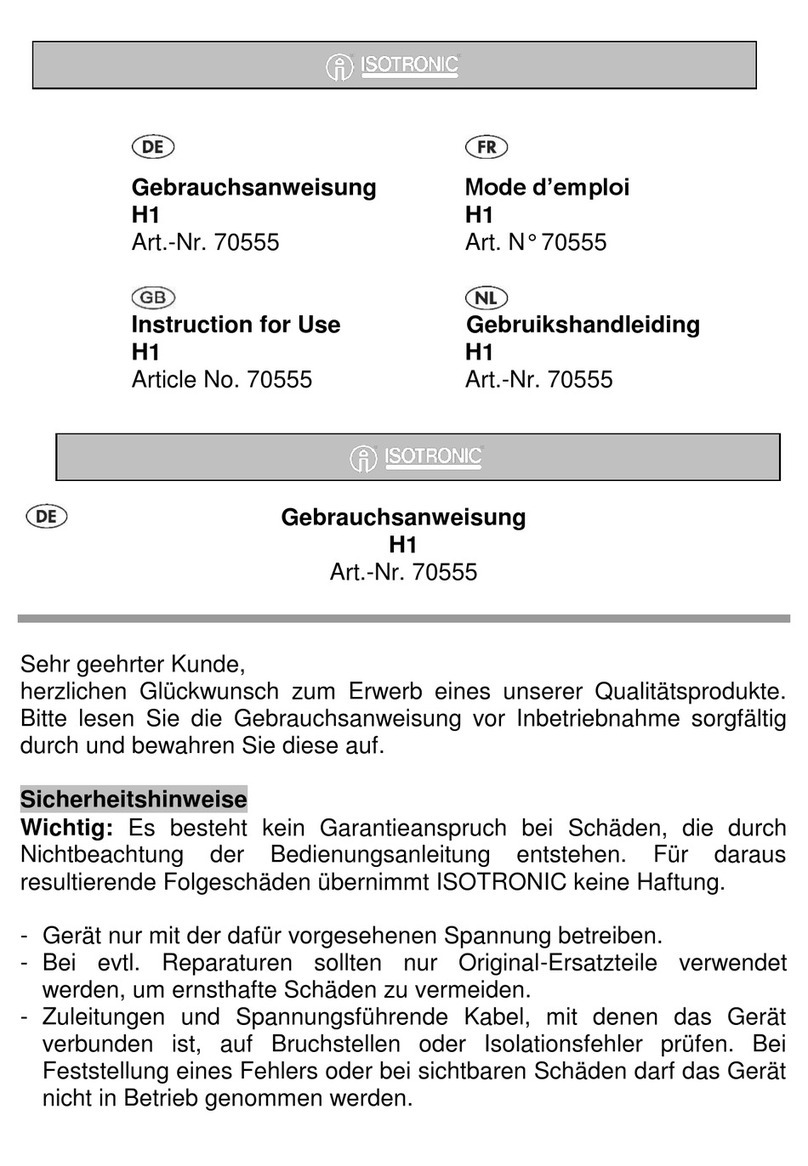
Isotronic
Isotronic H1 Instructions for use
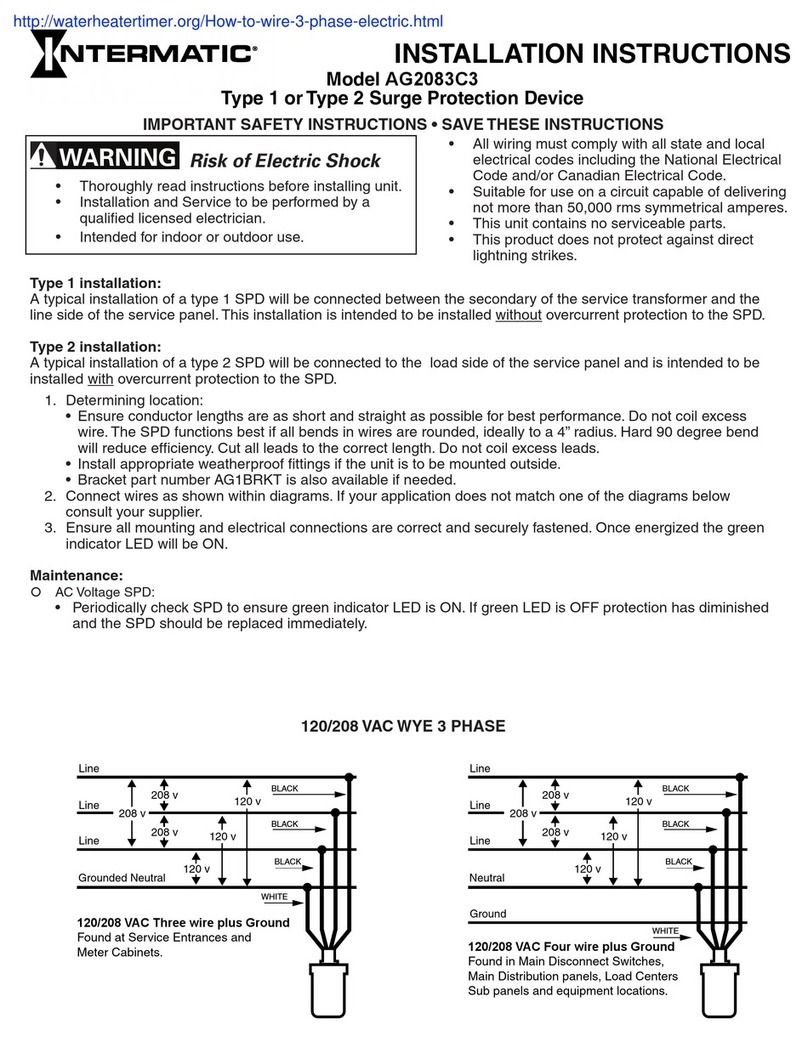
Intermatic
Intermatic AG2083C3 installation instructions

Morningstar
Morningstar GFPD-600V Installation and operation manual
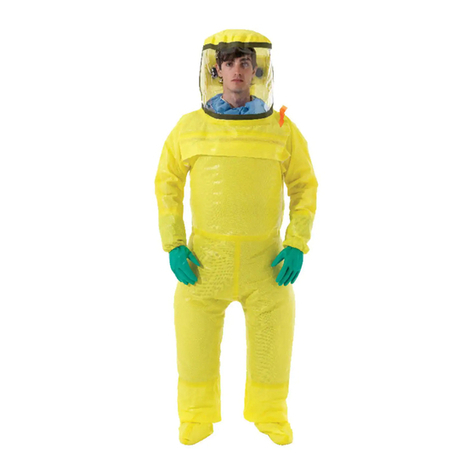
Microgard
Microgard 2500 PLUS PAPR Instructions for use

Sealey
Sealey WORKSAFE SSP80 instructions
